Pranshav Gajjar
AI5GTest: AI-Driven Specification-Aware Automated Testing and Validation of 5G O-RAN Components
Jun 11, 2025Abstract:The advent of Open Radio Access Networks (O-RAN) has transformed the telecommunications industry by promoting interoperability, vendor diversity, and rapid innovation. However, its disaggregated architecture introduces complex testing challenges, particularly in validating multi-vendor components against O-RAN ALLIANCE and 3GPP specifications. Existing frameworks, such as those provided by Open Testing and Integration Centres (OTICs), rely heavily on manual processes, are fragmented and prone to human error, leading to inconsistency and scalability issues. To address these limitations, we present AI5GTest -- an AI-powered, specification-aware testing framework designed to automate the validation of O-RAN components. AI5GTest leverages a cooperative Large Language Models (LLM) framework consisting of Gen-LLM, Val-LLM, and Debug-LLM. Gen-LLM automatically generates expected procedural flows for test cases based on 3GPP and O-RAN specifications, while Val-LLM cross-references signaling messages against these flows to validate compliance and detect deviations. If anomalies arise, Debug-LLM performs root cause analysis, providing insight to the failure cause. To enhance transparency and trustworthiness, AI5GTest incorporates a human-in-the-loop mechanism, where the Gen-LLM presents top-k relevant official specifications to the tester for approval before proceeding with validation. Evaluated using a range of test cases obtained from O-RAN TIFG and WG5-IOT test specifications, AI5GTest demonstrates a significant reduction in overall test execution time compared to traditional manual methods, while maintaining high validation accuracy.
ORANSight-2.0: Foundational LLMs for O-RAN
Mar 07, 2025
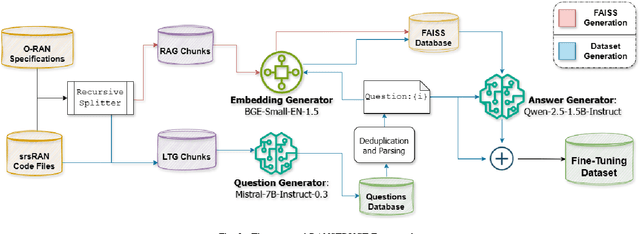

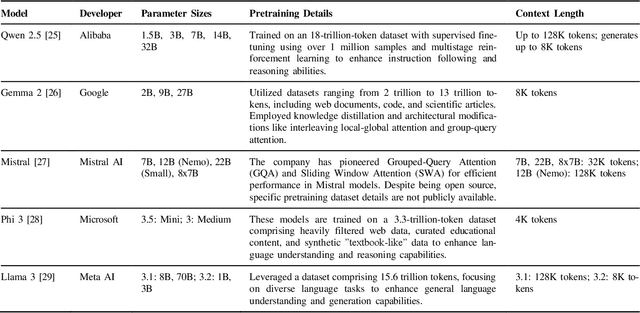
Abstract:Despite the transformative impact of Large Language Models (LLMs) across critical domains such as healthcare, customer service, and business marketing, their integration into Open Radio Access Networks (O-RAN) remains limited. This gap is primarily due to the absence of domain-specific foundational models, with existing solutions often relying on general-purpose LLMs that fail to address the unique challenges and technical intricacies of O-RAN. To bridge this gap, we introduce ORANSight-2.0 (O-RAN Insights), a pioneering initiative aimed at developing specialized foundational LLMs tailored for O-RAN. Built on 18 LLMs spanning five open-source LLM frameworks, ORANSight-2.0 fine-tunes models ranging from 1 to 70B parameters, significantly reducing reliance on proprietary, closed-source models while enhancing performance for O-RAN. At the core of ORANSight-2.0 is RANSTRUCT, a novel Retrieval-Augmented Generation (RAG) based instruction-tuning framework that employs two LLM agents to create high-quality instruction-tuning datasets. The generated dataset is then used to fine-tune the 18 pre-trained open-source LLMs via QLoRA. To evaluate ORANSight-2.0, we introduce srsRANBench, a novel benchmark designed for code generation and codebase understanding in the context of srsRAN, a widely used 5G O-RAN stack. We also leverage ORANBench13K, an existing benchmark for assessing O-RAN-specific knowledge. Our comprehensive evaluations demonstrate that ORANSight-2.0 models outperform general-purpose and closed-source models, such as ChatGPT-4o and Gemini, by 5.421% on ORANBench and 18.465% on srsRANBench, achieving superior performance while maintaining lower computational and energy costs. We also experiment with RAG-augmented variants of ORANSight-2.0 LLMs and thoroughly evaluate their energy characteristics, demonstrating costs for training, standard inference, and RAG-augmented inference.
ORAN-Bench-13K: An Open Source Benchmark for Assessing LLMs in Open Radio Access Networks
Jul 08, 2024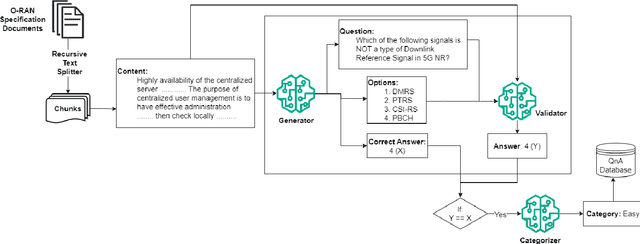
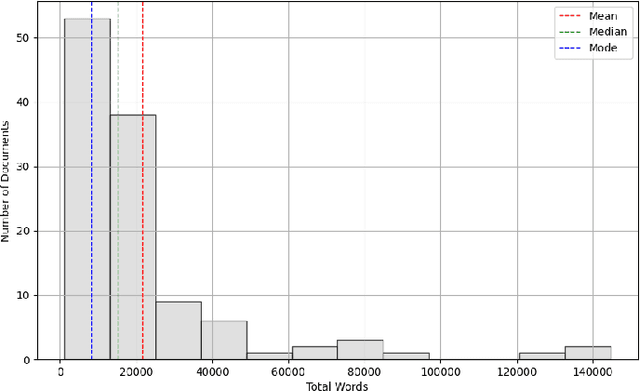
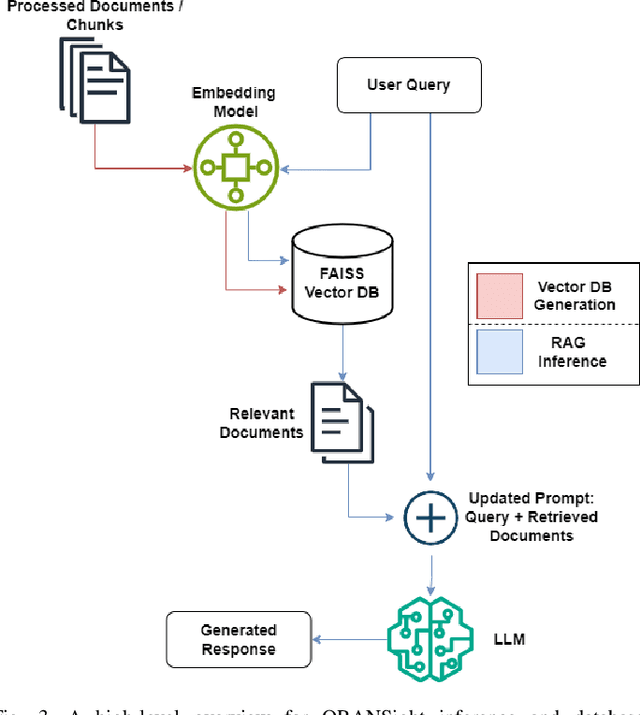
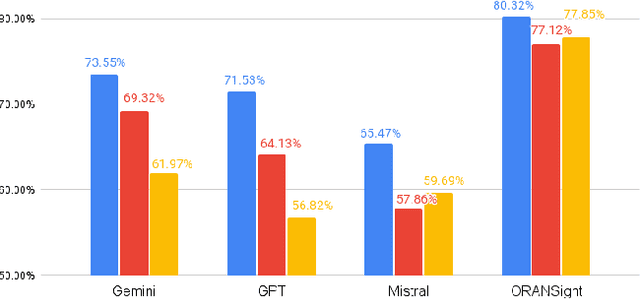
Abstract:Large Language Models (LLMs) can revolutionize how we deploy and operate Open Radio Access Networks (O-RAN) by enhancing network analytics, anomaly detection, and code generation and significantly increasing the efficiency and reliability of a plethora of O-RAN tasks. In this paper, we present ORAN-Bench-13K, the first comprehensive benchmark designed to evaluate the performance of Large Language Models (LLMs) within the context of O-RAN. Our benchmark consists of 13,952 meticulously curated multiple-choice questions generated from 116 O-RAN specification documents. We leverage a novel three-stage LLM framework, and the questions are categorized into three distinct difficulties to cover a wide spectrum of ORAN-related knowledge. We thoroughly evaluate the performance of several state-of-the-art LLMs, including Gemini, Chat-GPT, and Mistral. Additionally, we propose ORANSight, a Retrieval-Augmented Generation (RAG)-based pipeline that demonstrates superior performance on ORAN-Bench-13K compared to other tested closed-source models. Our findings indicate that current popular LLM models are not proficient in O-RAN, highlighting the need for specialized models. We observed a noticeable performance improvement when incorporating the RAG-based ORANSight pipeline, with a Macro Accuracy of 0.784 and a Weighted Accuracy of 0.776, which was on average 21.55% and 22.59% better than the other tested LLMs.
Preserving Data Privacy for ML-driven Applications in Open Radio Access Networks
Feb 15, 2024



Abstract:Deep learning offers a promising solution to improve spectrum access techniques by utilizing data-driven approaches to manage and share limited spectrum resources for emerging applications. For several of these applications, the sensitive wireless data (such as spectrograms) are stored in a shared database or multistakeholder cloud environment and are therefore prone to privacy leaks. This paper aims to address such privacy concerns by examining the representative case study of shared database scenarios in 5G Open Radio Access Network (O-RAN) networks where we have a shared database within the near-real-time (near-RT) RAN intelligent controller. We focus on securing the data that can be used by machine learning (ML) models for spectrum sharing and interference mitigation applications without compromising the model and network performances. The underlying idea is to leverage a (i) Shuffling-based learnable encryption technique to encrypt the data, following which, (ii) employ a custom Vision transformer (ViT) as the trained ML model that is capable of performing accurate inferences on such encrypted data. The paper offers a thorough analysis and comparisons with analogous convolutional neural networks (CNN) as well as deeper architectures (such as ResNet-50) as baselines. Our experiments showcase that the proposed approach significantly outperforms the baseline CNN with an improvement of 24.5% and 23.9% for the percent accuracy and F1-Score respectively when operated on encrypted data. Though deeper ResNet-50 architecture is obtained as a slightly more accurate model, with an increase of 4.4%, the proposed approach boasts a reduction of parameters by 99.32%, and thus, offers a much-improved prediction time by nearly 60%.
Optimization of Rocker-Bogie Mechanism using Heuristic Approaches
Sep 25, 2022



Abstract:Optimal locomotion and efficient traversal of extraterrestrial rovers in dynamic terrains and environments is an important problem statement in the field of planetary science and geophysical systems. Designing a superlative and efficient architecture for the suspension mechanism of planetary rovers is a crucial step towards robust rovers. This paper focuses on the Rocker Bogie mechanism, a standard suspension methodology associated with foreign terrains. After scrutinizing the available previous literature and by leveraging various optimization and global minimization algorithms, this paper offers a novel study on mechanical design optimization of a rovers suspension mechanism. This paper presents extensive tests on Simulated Annealing, Genetic Algorithms, Swarm Intelligence techniques, Basin Hoping and Differential Evolution, while thoroughly assessing every related hyper parameter, to find utility driven solutions. We also assess Dual Annealing and subsidiary algorithms for the aforementioned task while maintaining an unbiased testing standpoint for ethical research. Computational efficiency and overall fitness are considered key valedictory parameters for assessing the related algorithms, emphasis is also given to variable input seeds to find the most suitable utility driven strategy. Simulated Annealing was obtained empirically to be the top performing heuristic strategy, with a fitness of 760, which was considerably superior to other algorithms and provided consistent performance across various input seeds and individual performance indicators.
 Add to Chrome
Add to Chrome Add to Firefox
Add to Firefox Add to Edge
Add to Edge